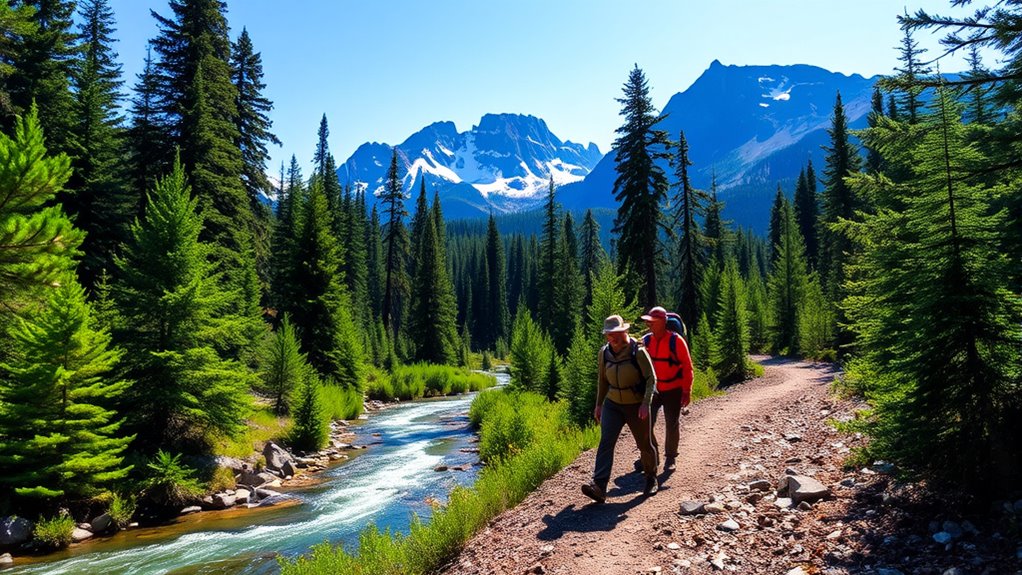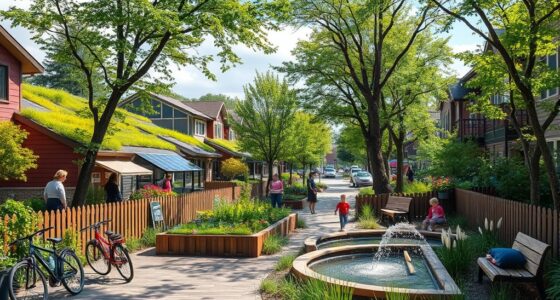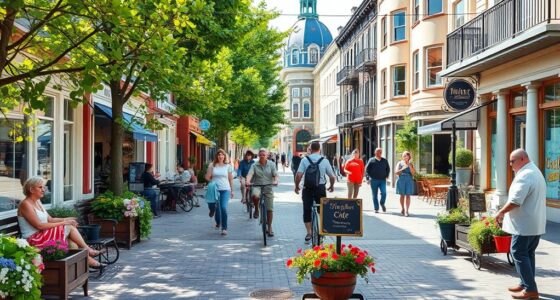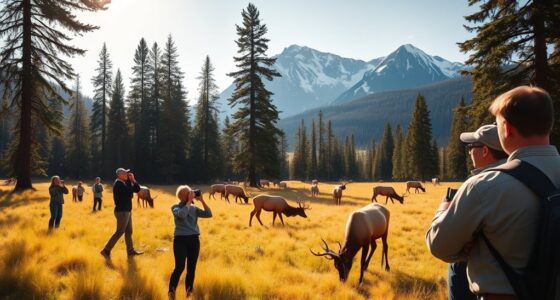Low-impact hiking in Yoho National Park helps protect its breathtaking landscapes and diverse ecosystems. Stick to established trails to minimize erosion and maintain natural beauty. Always pack out all waste and use reusable containers to keep the park clean. Wear sturdy, appropriate footwear to reduce trail damage while providing safety. Avoid disturbing wildlife by keeping noise levels low and observing from a distance. By practicing these principles, you can help preserve Yoho’s stunning environment for future generations. You’ll discover even more ways to make your hike sustainable.
Key Takeaways
- Stick to established trails to minimize soil erosion and protect the park’s natural beauty.
- Pack out all trash and waste, using reusable containers to reduce environmental impact.
- Wear sturdy, hiking-appropriate shoes to ensure safety and prevent trail damage.
- Maintain low noise levels and avoid feeding wildlife to preserve their natural behaviors.
- Observe flora and fauna respectfully, promoting stewardship and encouraging others to practice low-impact hiking.

Have you ever wondered how to enjoy the great outdoors while minimizing your impact on the environment? If you’re planning a hike in Yoho National Park, practicing low-impact hiking techniques can help you connect with nature without causing harm. One of the biggest concerns is trail erosion. When hikers stray off marked paths, they can create new trails, which can lead to soil erosion, damaging vegetation and the ecosystem. To combat this, stick to established trails. This not only protects the environment but also helps maintain the natural beauty of the park.
Before you head out, make sure you’re prepared. Packing out what you pack in is essential. Bring reusable containers for snacks and drinks to reduce waste. If you need to dispose of any trash, find the nearest waste bin or pack it out with you. You’ll also want to contemplate your footwear. Wearing sturdy shoes designed for hiking can help you navigate the terrain without causing unnecessary damage. By keeping your feet on the trail, you contribute to reducing trail erosion.
Wildlife disturbance is another important factor to keep in mind. Yoho is home to diverse wildlife, including bears, elk, and mountain goats. When you hike, you’ll want to minimize your presence to avoid disturbing these animals. This means keeping noise levels down and not feeding or approaching wildlife. If you spot an animal, enjoy the moment from a distance. Approaching can stress them out and disrupt their natural behaviors. Additionally, keeping food secured in bear-proof containers helps prevent attracting wildlife to your campsite.
On your hike, take time to observe the flora and fauna around you. Understand that every plant and animal plays a role in the ecosystem. By respecting their space, you’re helping maintain the balance of this beautiful environment. If you’re hiking with a group, encourage others to follow low-impact practices as well. It’s easier to protect the park when everyone’s on board. Remember, micro influencers often reflect real-life fashion, making trends accessible, and similar principles can be applied to fostering a culture of environmental stewardship among fellow hikers.
Frequently Asked Questions
What Are the Best Times of Year for Low-Impact Hiking in Yoho?
The best times for low-impact hiking in Yoho are late spring through early fall. During these seasons, you’ll encounter vibrant seasonal wildlife while minimizing trail erosion. Spring brings blooming flowers and active animals, while fall showcases stunning foliage. Aim to hike during weekdays to avoid crowds, which helps preserve the trails. Remember to stick to designated paths and avoid muddy areas to protect the environment and enhance your hiking experience.
Are There Any Guided Low-Impact Hiking Tours Available in the Park?
Yes, there are guided hikes and eco-friendly tours available in the park! These tours focus on minimizing environmental impact while providing you with an immersive experience. You’ll explore breathtaking trails with knowledgeable guides who share insights about the local flora and fauna. It’s a great way to enjoy nature responsibly. Just be sure to book in advance, especially during peak seasons, to secure your spot on these sustainable adventures!
What Should I Wear for Low-Impact Hiking in Yoho National Park?
For low-impact hiking, you’ll want to wear proper footwear, like sturdy hiking boots or shoes with good traction. They’ll keep your feet comfortable and supported. Weather-appropriate clothing is essential, too; opt for moisture-wicking layers that can adapt to changing conditions. A lightweight, waterproof jacket can be a lifesaver if it rains. Don’t forget a hat and sunglasses for sun protection, as well. Staying comfortable will make your hike more enjoyable!
Can I Bring My Dog on Low-Impact Hiking Trails in Yoho?
Yes, you can bring your dog on some trails in Yoho, but you need to verify which ones are dog friendly. Always keep your dog on a leash, as leash regulations are strictly enforced to protect wildlife and ensure everyone’s safety. Make sure to clean up after your pet and respect other hikers. Enjoy exploring the beautiful scenery together while being mindful of the park’s rules!
Are There Any Restroom Facilities on the Low-Impact Hiking Trails?
Yes, there are restroom facilities at some trailheads, but they might not be available directly on the low-impact hiking trails. Imagine starting your hike at the Emerald Lake trailhead, where you’ll find clean restrooms to freshen up before you hit the trail. As you venture further, be prepared for nature’s call, as restroom availability decreases along the paths. Always check for facilities at the trailhead to plan your hike accordingly!
Conclusion
As you lace up your boots and step onto the trails of Yoho National Park, remember that every footfall is a whisper in nature’s ear. By hiking with care, you’re not just exploring; you’re weaving a tapestry of respect for the wild. Let the gentle rustle of leaves and the soft murmur of streams guide you, and leave nothing but footprints behind. Embrace the beauty around you, and together, we’ll keep this breathtaking paradise thriving for generations to come.










